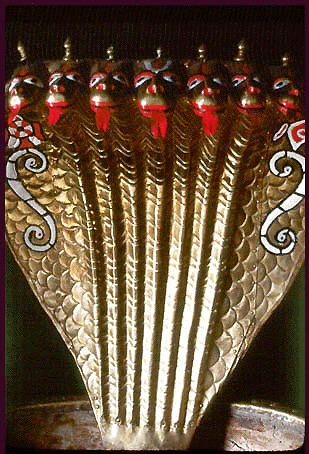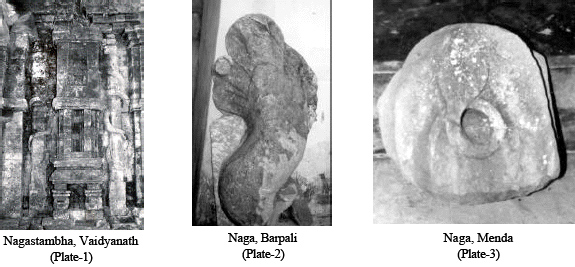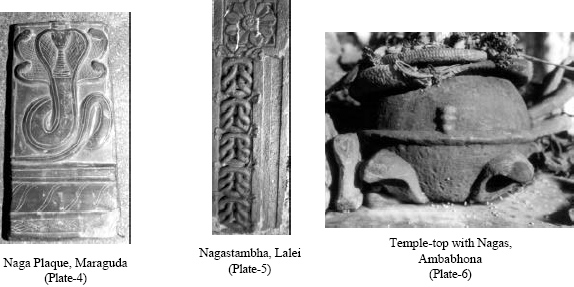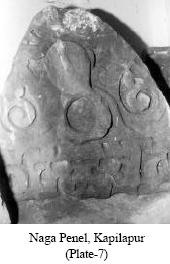Nagas in the Sculptural Decorations of Early West Orissan Temples
BY: SASANKA S. PANDA

Jan 7, ORISSA, INDIA (SUN) — A three-part study of the iconography of Nagas in Orissan art and architecture.
The Nagas are mentioned in the Puranas as a race of serpents who were inhabiting the Patalaloka, or the nether regions. We find descriptions on the origin of the Nagas in the Mahabharata and also in the Varaha Purana, according to which Rsi Kasyapa begot the seven great serpents: Vasuki, Taksaka, Karkotaka, Padma, Mahapadma, Sankhapala and Kulika by Daksayani, the daughter of Daksya. The Mayasilpa gives the detailed descriptions of these seven great Nagas: "The colour of Vasuki is pearl white; that of Taksaka glistening red and he must have on his hood the mark of Svastika. The colour of Karkotaka is black and on his hood there should be three white stripes; Padma is of the rosy hew of the lotus flower, with a white streak and adorned with coral ornaments. The colour of Mahapadma is white with the mark of Trisula on his head; whereas that of Sankhapala, is yellow with a white streak on his hood; the colour of Kulika is also red and his hood bears the mark of the crescent moon.
All these seven serpents should have two tongues and two arms and a hood with seven heads held over their human heads bearing all these gems. They must all be clad in one or three coats and carry in their hands an Aksamala and a Kamandalu." [1]
The Mahabharata story mentions these Nagas as the sons of Kadru and Kasyapa. [2] During the historic period, many parts of India were predominantly inhabited by a race of men, who were known by the name of the Nagas and they are said to have formed the majority of persons who joined the newly started Buddhist religion. [3]
In the Atharva Veda, Tirasciraji, Prdaku, Svaja, Kalmasagrivo and Svitro Nagas are mentioned as guardians (Raksita) of the southern, western, northern, eastern and upper quarters respectively. [4] The epic Naga Taksaka has been described as a descendant of Visala (Taksako Vaisaleyo) in one of the passages of Atharva Veda.[5] The names of snake gods like Tirasciraji, Asita, Svaja, Bhabru, Prdaku, Kankaparvan, Kairata, Prsna, Upatrnya, Taimata, Apodaka and Svitra are found in the Atharva Veda in different contexts.[6] They are associated in some passages of Atharva Veda with the Gandharvas, Apsaras, Punyajanas (Yaksas) and the Manes.[7] Dhrtarastra has been mentioned as a Nagaraja in later Brahmanical and Buddhist texts. According to a Mahabharata passage, he is the best of the Nagas.[8] Although the names of Nagas found in the Atharva Veda are not common in the Epic and Puranic texts, in the name of Babhruvahana, the son of Arjuna and the Naga princess Citrangada, we may find the survival of the vedic Babhru.[9] The Great Epic Mahabharata also mentions one Manimat, a Naga, and the name perhaps contains an allusion to the common belief persistent through the ages that the serpents bear jewels on their heads.[10] This belief is very old, as Varahamihira says, "The snakes of the lineage of Taksaka and Vasuki, and the snakes roaming at will(Kamagah) have bright blue-tinged pearls in their heads."[11] In the Mahabharata,[12] the Nagas said to be numbering in thousands and residing in Bhogavatipura, are described as strong and fierce by nature, adorned with jewels, Svastikas and wheels, and having the auspicious emblem of the Kamandalu; ..... some having twice five heads and other seven faced.

Hemadri [13] has quoted five couplets from Maya (evidently Mayasamgraha) where the features of the great Nagas, namely Taksaka, Karkotaka, Padma, Mahapadma, Sankhapala and Kulika are described in details.
In the Amsumadbhedagama, the iconography of Nagadeva (the chief of the Nagas) has been described as an image having three eyes, four hands, a beautiful countenance and of red colour. Above the head of the image there should be a five-hooded snake (cobra) canopy. The image of Nagadeva should be bedecked with a Karanda Mukuta on its head and all other ornaments and should be in the standing posture on a Padmapitha. The two front hands of Nagadeva should be in the Varada and Abhaya mudras, while both the back hands should hold a Sarpa (snake) in each. [14]
The Silparatna, a 17th century text gives the iconography of the Nagas as halfhuman and half-serpentine in shape, the lower part of the body below waist-portion being that of a snake. The serpent-hood, numbering one, three, five, seven or nine should be forming a conopy on their heads. They should have split tongues like those of the snakes and should carry a shield and a sword respectively in their hands.[15] The Matsya Purana[16] also mentions of Naga figures with exactly similar attributes, but does not state about the number of snake-hoods over their heads. Although Nagas in the theriomorphic (reptile) form are found depicted in the sculptural art of the Indus Valley Civilisation,[17] but in both the theriomorphic and anthropomorphic (half-human and half-serpent) forms can be traced in the sculptural art from around 6th century B.C., i.e. the time of Buddha.[18] A candidate for admission to the Buddhist Order was often asked whether he was a Naga or not.[19] The names of Naga kings like Virupakkha and Erapatha (Elapatra) frequently occur in Buddhist literature.[20] The Buddhist texts frequently refer also to various Naga chiefs like Muca (i) linda, Kaliya, Apalala and others who came to pay respect to the Buddha on different occasions. There are many early reliefs hailing from different parts of India where these themes are illustrated.[21] Passage in the Cullavagga mentions of serpent kings of four tribes (Ahiraja-kulani). They are Virupakkha, Erapatha, Chabyaputta and Kanhagotamaka.[22]
The depiction of Nagas in the purely serpent form is found profusely in the temple art of the upper Mahanadi valley of Orissa at least from the 7th-8th century onwards, and became a favourite theme mainly during the Somavamsi rule, i.e. 9th-11th century A.D.

Naga in the purely serpentine form with single hood is carved as coiled to a Stambha in both sides of the recess abutting the raha portion of the anartha on the northern outer wall of the brick-built Jagamohana hall at Vaidyanath. (Plate-1) This is the only instance of its kind, the Nagastambha having a Naga in the purely reptile form.[23] In the Silpa Prakasa [24] we find mention of this variation.
The theriomorphic form of Naga can be traced back to the time of the Indus Valley Civilisation, i.e. 2500-1800 B.C approximately.[25] Many terracotta Naga figurines of around 1650 B.C. have been unearthed at a placed called Chirand in Bihar also.[26] A beautiful theriomorphic Naga with five hoods is found in the plastic art at Bharhut, which is dated to the 2nd century B.C.[27]
Naga in the reptile form is always associated with Lord Siva and therefore, most of the stone images of the Naga in the reptile form are found either inside the Siva temples near the Sivalinga or in the temple precinct. Some references of the Naga in the reptile form are given by Vogel.[28]
Prof. Dr. Sadhu Charan Panda, during the survey for his doctoral research could locate three Naga images in the serpentine form in western Orissa and have cited about six Naga images in their theriomorphic representation in entire Orissa. He has further stated that those were independent objects of worship.[29] He has mentioned about the bust of a five-hooded Naga, found at Barpali in Bargarh district and assigns it to the pre-Gupta period. This image in the reptile form is of the size of around 27" in height and 15" in breadth. The upper portion, i.e. the bust is heavily rendered and the tail portion is missing. The middle hood is big in size, while other four hoods are smaller. This image is chiselled out in the complete round serpentine form out of a huge sand stone. (Plate-2)
Another Naga image in the serpentine form is found in the precinct of the Vindhyavasini temple at Sankirda village in the Bargarh district. It is unique in the sense that it is a python-type, having no hood.[30] Another Naga image located by Prof. Panda is that of a stone cobra of the size of around 15" in height and 4" in breadth at Ulapgad village in the Jharsuguda district. It displays very crude workmanship and is chiselled out of a small stone block, devoid of any art form. He thinks it to be of the late mediaeval period.[31] Such stone Naga images in the theriomorphic form are found at Menda, Lingmarni and Godhaneswar in Sonepur district, Layeda and Kapilapur in Jharsuguda district, Jaypurgad near Kuchinda in Sambalpur district and Lalei in Sundergarh district of Western Orissa.
Some loose sculptures, certainly belonging to a temple of the early period are kept inside the temple of goddess Mendasuni at Menda in the Sonepur district. Amidst those sculptures, two broken portions of the temple wall, having theriomorphic coiled form of a snake (Naga) with its raised single hood were located by this scholar during exploration.[32] (Plate-3) The antiquities of Menda have been assigned to the pre-Somavamsi period, i.e. circa 7th-8th century A.D. But at least those sculptures can be dated to the second half of the 9th century A.D. as the name of this village has been mentioned as Meranda in the Vakratentuli copper-plate grant of the Somavamsi king Mahabhavagupta Janmejaya I (Reigning Period : circa 850-885 A.D.).[33] Such stone panel depicting Nagas is found in a Siva temple at Kapilapur in Jharsuguda district. (Plate-5)

In a village named Lingmarni, which is situated at a distance of around 15 kms from Dungripali, a Panchayat Samittee (Block) head-quarters of Sonepur district, a big raised snake-hood canopy, made of stone is forming an umbrella over the Sivalinga of the Siva temple. Such a big stone Naga with single hood and in the purely serpentine form is found also in the open field, just in front of the Godhanesvara Siva temple at Godhanesvar in the Birmaharajpur revenue sub-division of Sonepur district. The Naga image of Godhanesvara is of the height of around three feet and has a raised head.[34] Another unique Naga sculpture is found in the Siva temple at Lingmarni. It is a serpentine Naga, coiled around one small round-shaped pillar with its five-hooded canopy raised up.
A diminutive Sivalinga is carved just below the five-hooded snake-canopy on the body of the snake. One such five-hooded Naga in the reptile form, carrying a Sivalinga on its central hood is found carved on a red soft-stone plaque. It was found at Maraguda Valley by one villager named Rup Singh Kuanr in the month of September, 1980 while doing earth work on the embankment of a huge reservoir called Raital Sagar and is at present kept in the private possession of the noted historian Rajasaheb Jitamitra Prasad Singh Deo of Khariar. This flat Naga sculpture of Maraguda is measuring around 7 inches in height and 3.5 inches in breadth. (Plate-4) Such pieces of sculptural art of depicting Nagas on flat stone plaques have been found during excavations at Sirpur and are exhibited in Mahant Ghasidas Museum at Raipur in Chhatisgarh state.[35]
Rudresvara Siva temple is standing on the left bank of Bheden river and situated at a distance of nearly 15 kms to the east of Kuchinda, a sub-divisional head-quarter of Sambalpur district. The Sivalinga inside the Garbhagrha of this temple is under a single-hooded stone Naga, forming a canopy over it. Another single-hooded stone Naga of the height of around two feet is also found inside the Garbhagrha. The back-side of this stone block bearing the bigger Naga in the serpentine form has been made like the bottom portion of a boat, as in the case of the Nagaraja image from Maraguda in the Nuapada district. This area was ruled by Ranaka Sri Punja of the Mathara dynasty, who was a vassal king under the Somavamsi monarch Mahabhavagupta Udyota Kesari (Reigning Period: Circa 1040-1065 A.D.[36]
In a village called Lalei situated on the left bank of river Brahmani, a Naga pillar, depicting five Naga couples in purely serpentine form are carved as intertwined with each other. A nine-petalled lotus medallion motif is carved on the top portion of this pillar. (Plate-5) Such a beautiful Naga pillar depicting intertwined Nagas is not found anywhere else in Orissa.[37]
In another place called Ambabhona in the Bargarh district, a round stone piece (Mastaka) is kept in the north-east side of the Kedarnath Siva temple. Four single-hooded Nagas in the theriomorphic form are carved in all four corners in the lower portion of this round Mastaka-portion of an early temple. This architectural fragment can be dated to the 11th-12th century A.D. (Plate-6) Another stone panel, which was once upon a time adorning the wall of a temple is kept inside a Siva temple at Kapilapur in the Lakhanpur Panchayat Samittee (block) area of Jharsuguda district. It depicts a single-hooded Naga, flanked by two miniature Nagas in both sides. (Plate-7) This panel which was collected from the temple ruins of Mahadevpali can be assigned to the 12th century A.D., when this area was captured by the Kalachuri kings of Ratanpur Branch.
Footnotes
1. Rao, T.A. Gopinatha; Elements of Hindu Iconography, Vol.II, Part-II, Indological Book House, Varanasi, 1971, pp.554-447.
2. Ibid, p.554.
3. Ibid, p.555.
4. Banerjea, J.N.; The Development of Hindu Iconography, Munshiram Manoharlal Publishers Pvt. Ltd., New Delhi, 3rd Edition, January 1974, p.345.
5. Atharva Veda, VIII, p.10, 29.
6. Atharva Veda, III, 26 & 27; V.13, 5-6; VII 56, 1 : X. 4,13.
7. Atharva Veda, VIII, 8, 15. (Gandharvapsarasah sarpandevanpunyajananpitrrn).
8. Mahabharata, IV. 2, 17.
9. Banerjea, op.cit., Fn, p.345.
10. Banerjea, op.cit., p.345-346.
11. Brhatsamhita, LXXXI, 25.
12. Mahabharata, Udyogaparva, XCVII-CV).
13. Hemadri; Caturvargacintamani, Vratakhanda, pt.II, p.139.
14. Rao, Op.cit, p.556
15. Rao, Ibid.
16. Matsya Purana, Ch. 262, p.48-49.
17. Marshall, John H.; Mahenjodaro and the Indus Civilisation, London, 1931, p.68, Pls.XVIII, II and CXVI.29.
18. Benerjea, J.N.; The Development of Hindu Iconography, Munshiram Manoharlal Publishers Pvt. Ltd., New Delhi, 3rd Edition, January 1974, p.346.
19. Grunweden, Buddhist Art, p.44.
20. Vogel, J.Ph.; Indian Serpent Lore, London, 1936, p.10.
21. Banerjea, op.cit., p.346.
22. Cullavagga, V.6.
23. Dehejia, Vidya; Early Stone Temples of Orissa, Vikas Publishing House Pvt. Ltd., New Delhi, 1979, p.54.
24. Silpa Prakasa, II, 294, p.87.
25. Marshall, John H.; Mahenjodaro and the Indus Civilisation, Vol.I, London, 1931, p.68, pls.XVIII : 11 and XVI : 29.
26. Sankalia, H.D.; Pre-history and Proto-history of India and Pakistan, Poona, 1974, pp.304 and 307.
27. Bussaglio, M.; 5000 Years of Art of India, New York, p.63, pl.66.
28. Vogel, J.Ph.; Indian Serpent Lore, London, 1926, p.36.
29. Panda, Sadhu Charan; Naga Cult in Orissa, B.R. Publishing Corporation, Delhi, 1986, pp.53-55 ff.
30. Ibid, p.54.
31. Ibid, p.55. Panda, Sasanka Sekhar; Some Archaeological Ramains of Balangir District, The Orissa Historical Research Journal, Bhubaneswar, 1995, Vol.XXXX, No.1-4, p.74.
33. Mazumdar, B.C.; (edited by), Epigraphia Indica, XI, pp.93-95 ff.
34. Panda, Sasanka Sekhar; op. cit., p.79.
35. Singh Deo, Jitamitra Prasad; Cultural Profile of South Kosala, Gian Publishing House, Delhi, 1987, pp.328, 364 & 368.
36. Kudopali Plates of the time of Mahabhavagupta, edited by Dr. Kielhorn, Epigraphia Indica, Vol.IV, pp.254-59; edited by Satyanarayan Rajaguru, Inscriptions of Orissa, Vol.IV, pp.237-40 ff.
37. Panda, Sasanka Sekhar; Two Hitherto Unknown Temple Ruins of Sundargarh District, The Orissa Historical Research Journal, Vol.XLVI, No.1, 2003, p.58.
